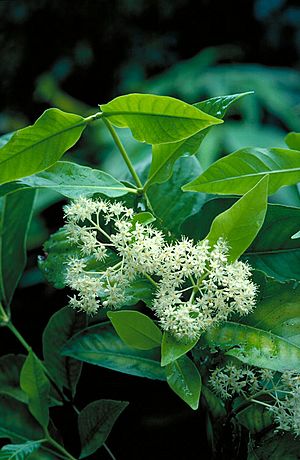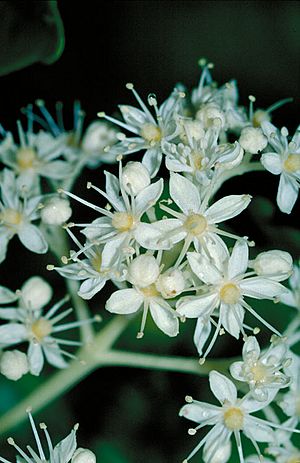Northern towra facts for kids
Quick facts for kids Northern towra |
|
|---|---|
 |
|
| Scientific classification | |
| Genus: |
Bosistoa
|
| Species: |
medicinalis
|
| Synonyms | |
|
|
The northern towra (scientific name: Bosistoa medicinalis) is a special kind of tree. It is also known as the Eumundi bosistoa. This tree is a small to medium-sized rainforest tree. It is found only in Queensland, Australia. This means it is endemic to Queensland.
The northern towra has simple leaves and also pinnate leaves. Pinnate leaves look like a feather, with smaller leaflets growing off a main stem. These leaves usually have two or three leaflets. The tree also grows small white flowers in groups called panicles.
Contents
What the Northern Towra Looks Like
The northern towra is a tree that can grow up to 20 meters (about 65 feet) tall. It has bark that feels hard.
Leaves
The leaves of this tree grow in pairs, opposite each other on the stem. Most of the time, a leaf has three smaller parts called leaflets. These leaflets are shaped like an egg. Each leaflet is about 3.5 to 14 centimeters (1.4 to 5.5 inches) long. They are also about 1 to 5.5 centimeters (0.4 to 2.2 inches) wide. The last leaflet on a stem has its own small stalk, called a petiolule. Sometimes, the leaves can have just one or two leaflets instead of three.
The leaves have tiny oil glands that you can see. The tip of each leaflet is usually pointed. At the end of each twig, there are two simple leaves and a new bud ready to grow.
Flowers and Fruit
The northern towra's flowers grow in groups called panicles. These panicles are about 5 to 10 centimeters (2 to 4 inches) long. The flowers have small green parts called sepals at their base. These sepals are less than 1 millimeter long. The white petals of the flowers are about 3 to 4.5 millimeters long.
This tree usually flowers from February to October. After the flowers, the tree grows fruit. The fruit is an oval or round follicle. A follicle is a dry fruit that splits open on one side to release seeds. These follicles are about 9 to 12 millimeters long. They become ripe between October and March. Inside the fruit, the seeds are oval or kidney-shaped, about 8 millimeters long.
How it Got its Name
The northern towra was first officially described in 1866. A scientist named Ferdinand von Mueller gave it the name Pagetia medicinalis. He wrote about it in a book called Fragmenta phytographiae Australiae.
Later, in 1977, another scientist named Thomas Gordon Hartley changed its name. He renamed it Bosistoa medicinalis. This new name was published in a science journal called the Journal of the Arnold Arboretum.
Where the Northern Towra Lives
The northern towra grows in rainforests. It often lives in dry rainforests. You can find it in areas near the coast in Queensland. Its range stretches from the Pascoe River in northern Queensland all the way down to Woombye in south-eastern Queensland.
How it is Protected
The Queensland Government has a law called the Nature Conservation Act 1992. Under this law, the northern towra is listed as being of "least concern." This means that, for now, there are enough of these trees. They are not currently considered to be in danger of disappearing.


